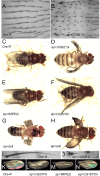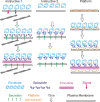The Gene Expression Program for the Formation of Wing Cuticle in Drosophila
- PMID: 27232182
- PMCID: PMC4883753
- DOI: 10.1371/journal.pgen.1006100
The Gene Expression Program for the Formation of Wing Cuticle in Drosophila
Abstract
The cuticular exoskeleton of insects and other arthropods is a remarkably versatile material with a complex multilayer structure. We made use of the ability to isolate cuticle synthesizing cells in relatively pure form by dissecting pupal wings and we used RNAseq to identify genes expressed during the formation of the adult wing cuticle. We observed dramatic changes in gene expression during cuticle deposition, and combined with transmission electron microscopy, we were able to identify candidate genes for the deposition of the different cuticular layers. Among genes of interest that dramatically change their expression during the cuticle deposition program are ones that encode cuticle proteins, ZP domain proteins, cuticle modifying proteins and transcription factors, as well as genes of unknown function. A striking finding is that mutations in a number of genes that are expressed almost exclusively during the deposition of the envelope (the thin outermost layer that is deposited first) result in gross defects in the procuticle (the thick chitinous layer that is deposited last). An attractive hypothesis to explain this is that the deposition of the different cuticle layers is not independent with the envelope instructing the formation of later layers. Alternatively, some of the genes expressed during the deposition of the envelope could form a platform that is essential for the deposition of all cuticle layers.
Conflict of interest statement
The authors have declared that no competing interests exist.
Figures








Similar articles
-
Gene expression and morphogenesis during the deposition of Drosophila wing cuticle.Fly (Austin). 2017 Jul 3;11(3):194-199. doi: 10.1080/19336934.2017.1295188. Epub 2017 Feb 17. Fly (Austin). 2017. PMID: 28631994 Free PMC article.
-
Analysis of expression and chitin-binding activity of the wing disc cuticle protein BmWCP4 in the silkworm, Bombyx mori.Insect Sci. 2016 Dec;23(6):782-790. doi: 10.1111/1744-7917.12231. Epub 2015 Oct 26. Insect Sci. 2016. PMID: 25953667
-
Chitinase 10 controls chitin amounts and organization in the wing cuticle of Drosophila.Insect Sci. 2020 Dec;27(6):1198-1207. doi: 10.1111/1744-7917.12774. Epub 2020 Aug 5. Insect Sci. 2020. PMID: 32129536
-
The regulation of expression of insect cuticle protein genes.Insect Biochem Mol Biol. 2010 Mar;40(3):205-13. doi: 10.1016/j.ibmb.2009.12.005. Epub 2010 Jan 7. Insect Biochem Mol Biol. 2010. PMID: 20060042 Review.
-
Chitin in Arthropods: Biosynthesis, Modification, and Metabolism.Adv Exp Med Biol. 2019;1142:169-207. doi: 10.1007/978-981-13-7318-3_9. Adv Exp Med Biol. 2019. PMID: 31102247 Review.
Cited by
-
Trynity controls epidermal barrier function and respiratory tube maturation in Drosophila by modulating apical extracellular matrix nano-patterning.PLoS One. 2018 Dec 21;13(12):e0209058. doi: 10.1371/journal.pone.0209058. eCollection 2018. PLoS One. 2018. PMID: 30576352 Free PMC article.
-
Insect Mouthpart Transcriptome Unveils Extension of Cuticular Protein Repertoire and Complex Organization.iScience. 2020 Feb 21;23(2):100828. doi: 10.1016/j.isci.2020.100828. Epub 2020 Jan 9. iScience. 2020. PMID: 32000126 Free PMC article.
-
Live Detection of Intracellular Chitin in Butterfly Wing Epithelial Cells In Vivo Using Fluorescent Brightener 28: Implications for the Development of Scales and Color Patterns.Insects. 2023 Sep 8;14(9):753. doi: 10.3390/insects14090753. Insects. 2023. PMID: 37754721 Free PMC article.
-
Lint, a transmembrane serine protease, regulates growth and metabolism in Drosophila.Genetics. 2021 May 17;218(1):iyab035. doi: 10.1093/genetics/iyab035. Genetics. 2021. PMID: 33693655 Free PMC article.
-
Cellular heterogeneity of the developing worker honey bee (Apis mellifera) pupa: a single cell transcriptomics analysis.G3 (Bethesda). 2023 Sep 30;13(10):jkad178. doi: 10.1093/g3journal/jkad178. G3 (Bethesda). 2023. PMID: 37548242 Free PMC article.
References
-
- Vincent JF, Wegst UG. Design and mechanical properties of insect cuticle. Arthropod structure & development. 2004;33(3):187–99. - PubMed
-
- Moussian B, Veerkamp J, Muller U, Schwarz H. Assembly of the Drosophila larval exoskeleton requires controlled secretion and shaping of the apical plasma membrane. Matrix biology: journal of the International Society for Matrix Biology. 2007;26(5):337–47. - PubMed
-
- Payre F. Genetic control of epidermis differentiation in Drosophila. The International journal of developmental biology. 2004;48(2–3):207–15. - PubMed
-
- Vincent JF. Deconstructing the design of a biological material. Journal of theoretical biology. 2005;236(1):73–8. - PubMed
Publication types
MeSH terms
Substances
Grants and funding
LinkOut - more resources
Full Text Sources
Other Literature Sources
Molecular Biology Databases

